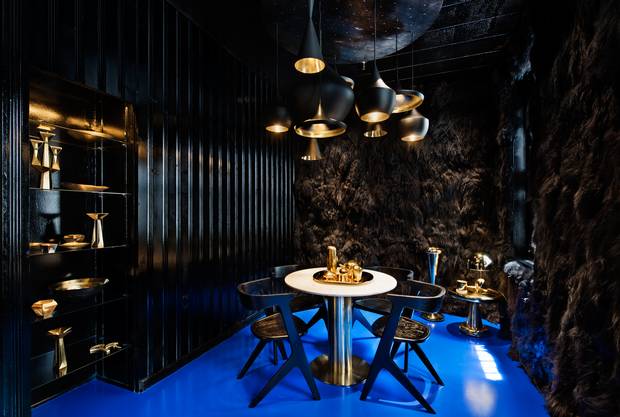When the Brazilian design superstars Campana Brothers, Humberto and Fernando, released their Cipria faux fur sofa, the playful settee, manufactured by the Italian company Edra, not only moved the fluffy synthetic away from novelty textiles, but set in motion a new interest in extreme texture. Similarly, British designer Tom Dixon is stoking wooly wonder with his newly opened New York City flagship, which features a "furry room," complete with brown faux fur wallpaper that looks like the hide of Chewbacca's long lost cousin. Brace yourself devotees of the slicker end of the home decor spectrum, because things are about to get hairy.
Last April, at the Milan Furniture Fair, Dixon gave his iconic blue Wingback chair a fur treatment. A few rooms over, the fast-raising Rotterdam-based designer Tijmen Smeulders exhibited his own perfectly coiffed blue bench, made out of a unique take on faux fur: CNC-tufted polyester yarns. More traditional designers are turning to shearling as a luxe alternative to wool upholstery. To celebrate its 50th anniversary, B&B Italia released a 50-piece limited edition of Naoto Fukasawa's 2009 Grande Papilio chair, with its sculptural butterfly shape completely covered in 50 shades of luxurious white shearling. Los Angeles-based design studio Commune collaborated with West Elm on a cozy chair, upholstered in patchwork shearing. The material often associated with outdoor ruggedness even received the ultra glam treatment from Kelly Wearstler, the grande dame of Hollywood Regency design, in the form of a petite stool mounted on gold, human-shaped feet.
Where hair is concerned, no other animal has made an impact on interior design as much as the horse. The majestic animal's hair has been used in furniture since the Middle Ages, as both upholstery and stuffing. In 1837, John Boyd, a travelling textile merchant from Scotland, established the first horsehair-only textile company, which is still in operation today. Its luxurious fabrics grace the lobbies of some of the word's most prestigious hotels, including the Mandarin Oriental in London. John Boyd Textiles' extensive inventory features a range by Dutch textile artist Marianne Kemp, a premiere horsehair weaver. She also collaborated with fellow Dutch designer and felt specialist Anneke Hoogervorst on a highly textured line of cushions titled Script, for their cursive lines of delicate horsehair.
Breaking away from upholstery, New York-based designers Gabriel Hendifar and Jeremy Anderson of Apparatus use horsehair as rope in their line of pendants and sconces. Wefts of silky horsehair are combined with brass and glass in streamlined shapes that emphasize the fibre as much for its function as its beauty. The animal interest doesn't stop there. Cowhides are adopting more geometric compositions, as intricate patchwork patterns are explored by leading design retailers, from CB2 to Design Within Reach. And the classic Scandinavian sheepskin is ever present in stylish spaces, whether on a floor or draped on a piece of furniture.
High pile or shag rugs, once ubiquitous in the seventies, are gaining popularity after a decade of flat weaves. Wools, cottons and linens can, of course, mimic fur in a convincing way. The classic Fogg long-pile rug by the late Gunilla Lagerhhelm Ullberg for Kasthall is comprised of thousands of soft linen stalks reminiscent of a badger's coat. The asymmetrical, organic-shaped Nudo rug by Sebastian Herkner for Ames Sala, which also debuted at the Milan fair, resembles an animal throw with its multi-textured composition.
Beastly items are plentiful in the home accessories department too with fuzzy pillows and throws ranging from classic Mongolian lamb cushions to faux-fur blankets. Some makers take a more abstract approach, like the Shaggy Dog tweed pillow by famed Northern Ireland weavers Mourne Textiles. The canine-inspired tweed first made an appearance in Irish fashion designer Sybil Connolly's coat collection in the 1950s.
Mourne's whimsical spirit evokes a similar sense of humour as the Campana Brothers's work. This summer, they wrapped an entire house in Sao Paulo with strips of palm fibre, creating a novel structure that resembled Cousin It from The Adams Family. The house's hairy façade helps regulate temperatures, providing a cooling cocoon from the tropical climate. There's no word on how often it – or any of its hairy household counterparts – need to be groomed.
